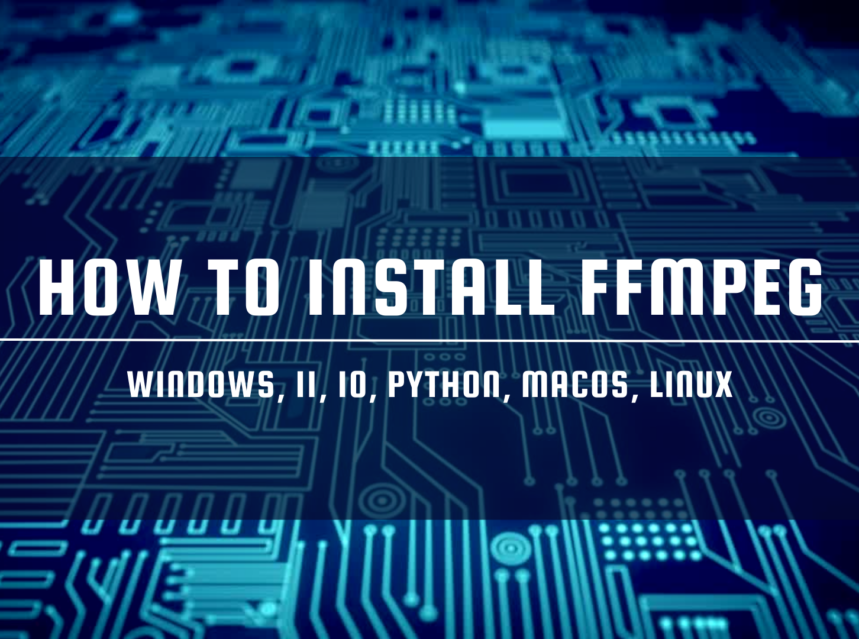How to Install Ffmpeg, Windows 11, 10, Python, Mac, Linux ⏬👇

Installing Ffmpeg is a crucial step for anyone looking to work with multimedia content, whether it’s video editing, audio processing, or multimedia playback. Ffmpeg is a powerful, open-source software suite that provides a versatile solution for handling various multimedia formats and tasks. This guide will walk you through the process of install Ffmpeg on your system, enabling you to harness its capabilities and unlock a world of possibilities for your multimedia projects. Whether you’re a content creator, developer, or multimedia enthusiast, having Ffmpeg at your disposal is a valuable asset in today’s digital landscape.
What is FFmpeg
FFmpeg is a powerful and open-source software suite designed for handling multimedia data, including audio, video, and various multimedia files. It is a command-line tool and a collection of libraries that allows users to perform a wide range of multimedia-related tasks, such as:
Audio and Video Conversion: FFmpeg can convert audio and video files from one format to another. This includes encoding and decoding various codecs and container formats.
Video Editing: It provides capabilities for video editing, such as cutting, trimming, merging, and adding subtitles to videos.
Streaming: FFmpeg can be used for both streaming media content over the internet and capturing streams from various sources.
Screen Recording: It can capture the screen and record it as a video file.
Audio and Video Processing: FFmpeg can apply various filters, effects, and transformations to audio and video streams.
Transcoding: It is commonly used in multimedia transcoding applications, allowing you to adapt media files for different devices and platforms.
Media Analysis: FFmpeg can provide detailed information about media files, including their codecs, resolutions, bitrates, and more.
Multimedia Playback: It can also be used as a player for multimedia files.
FFmpeg is a versatile and widely used tool in the multimedia industry and is available for various platforms, including Windows, macOS, Linux, and more. Many multimedia applications, video editing software, media players, and streaming services utilize FFmpeg’s libraries and features to handle multimedia content efficiently. It is a valuable tool for developers, content creators, and anyone working with multimedia files.
Install Ffmpeg Windows 11 and Windows 10
To install FFmpeg on both Windows 10 and Windows 11, you can follow the same steps, as the installation process remains consistent across these versions of Windows. Here’s how to install FFmpeg on Windows 10 and Windows 11:
Download FFmpeg:
- Visit the official FFmpeg website at https://ffmpeg.org/download.html.
- Scroll down to the “Windows” section.
Choose a Build:
- On the FFmpeg download page, you will find several builds available for download. Select the build that suits your needs. The most commonly used build is usually labeled as “ffmpeg-release-full,” but you can choose others based on your requirements.
Download the Build:
- Click on the link to download the selected build. This will usually be a .zip file.
Extract the ZIP File:
- After the download is complete, extract the contents of the ZIP file to a location on your computer. You can do this by right-clicking the ZIP file and selecting “Extract All.”
Add FFmpeg to System Path (Optional):
- To use FFmpeg from the command line without specifying its full path, you can add the folder containing the FFmpeg executable to your system’s PATH environment variable. Here’s how:
- Right-click on the “This PC” or “My Computer” icon and select “Properties.”
- Click on “Advanced system settings” on the left sidebar.
- In the System Properties window, click the “Environment Variables” button.
- Under “System Variables,” find and select “Path,” then click “Edit.”
- Click “New” and add the path to the folder where you extracted FFmpeg (e.g., C:\path\to\ffmpeg\bin).
- Click “OK” to close all the windows.
Verify Installation:
- Open a Command Prompt or PowerShell window.
- Type ffmpeg -version and press Enter. You should see information about the FFmpeg version if the installation was successful.
That’s it! You’ve successfully installed FFmpeg on both Windows 10 and Windows 11. You can now use FFmpeg for various multimedia tasks from the command line.
Install Ffmpeg Python
To install FFmpeg for Python, you can use the “imageio-ffmpeg” package, which provides FFmpeg bindings for Python. Here’s how to install it using pip:
Open a Command Prompt or Terminal:
- On Windows, you can press Win + R, type “cmd,” and press Enter.
- On macOS or Linux, open your Terminal.
Install the “imageio-ffmpeg” Package:
- Use pip to install the package by running the following command:
pip install imageio[ffmpeg]This command installs the “imageio-ffmpeg” package along with FFmpeg support.
Verify the Installation:
- To verify that the installation was successful, you can open a Python shell or script and import the “imageio” module with FFmpeg:
import imageio_ffmpeg as ffmpegCheck FFmpeg versionprint(ffmpeg.get_ffmpeg_version())This should print the installed FFmpeg version.
That’s it! You’ve successfully installed FFmpeg for Python using the “imageio-ffmpeg” package. You can now use FFmpeg functionality within your Python scripts.
Install Ffmpeg Mac
You can install FFmpeg on macOS using Homebrew, which is a popular package manager for macOS. Here are the steps to install FFmpeg on macOS using Homebrew:
Open Terminal:
- Launch the Terminal app on your Mac. You can find it in the “Utilities” folder within the “Applications” folder.
Install Homebrew (if you haven’t already):
- If you don’t have Homebrew installed, you can install it by running the following command in the Terminal:
/bin/bash -c "$(curl -fsSL https://raw.githubusercontent.com/Homebrew/install/HEAD/install.sh)"Follow the on-screen instructions to complete the installation.
Install FFmpeg:
- Once Homebrew is installed, you can install FFmpeg by running the following command:
brew install ffmpegHomebrew will download and install FFmpeg and its dependencies.
Verify the Installation:
- To verify that FFmpeg has been successfully installed, you can run the following command in the Terminal:
ffmpeg -versionThis command should display information about the installed FFmpeg version.
That’s it! You’ve successfully installed FFmpeg on your macOS using Homebrew. You can now use FFmpeg for various multimedia tasks from the Terminal.
Install Ffmpeg Linux
To install FFmpeg on a Linux-based system, you can use your system’s package manager. The exact commands may vary depending on your Linux distribution. Here are instructions for some popular Linux distributions:
Ubuntu or Debian:
- Open a terminal window.
- Update the package list to ensure you have the latest information about available packages:
sudo apt updateInstall FFmpeg:
sudo apt install ffmpegVerify the installation:
ffmpeg -versionCentOS or RHEL:
- Open a terminal window.
- Update the package list:
sudo yum updateInstall FFmpeg:
sudo yum install ffmpegVerify the installation:
ffmpeg -versionFedora:
- Open a terminal window.
- Update the package list:
sudo dnf updateInstall FFmpeg:
sudo dnf install ffmpegVerify the installation:
ffmpeg -versionThe above instructions cover some of the most commonly used Linux distributions. If you are using a different distribution, the package manager and package name may vary, so you should consult your distribution’s documentation or package manager for specific instructions on how to install FFmpeg.



